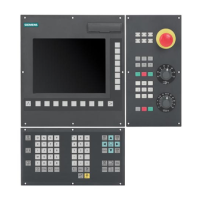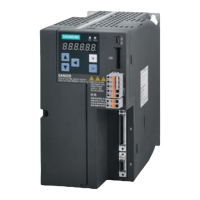Programming technology functions (cycles)
8.5 Contour milling
Turning
Operating Manual, 03/2013, 6FC5398-8CP40-3BA1
441
parameters Description Unit
Starting point
L1
ϕ1
Distance to pole, end point (abs)
Polar angle to the pole, end point (abs)
mm
Degrees
Additional commands You can program feedrates and M commands, for example, using additional G
code commands. However, carefully ensure that the additional commands do
not collide with the generated G code of the contour and are compatible with
the machining type required. Therefore, do not use any G code commands of
group 1 (G0, G1, G2, G3), no coordinates in the plane and no G code
commands that have to be programmed in a separate block.
The contour is finished in continuous-path mode (G64). As a result, contour
transitions such as corners, chamfers or radii may not be machined precisely.
If you wish to avoid this, then it is possible to use additional commands when
programming.
Example: For a contour, first program the straight X parallel and then enter
"G9" (non-modal exact stop) for the additional command parameter. Then
program the Y-parallel straight line. The corner will be machined exactly, as the
feedrate at the end of the X-parallel straight line is briefly zero.
Note:
The additional commands are only effective for path milling!
8.5.4 Creating contour elements
After you have created a new contour and specified the starting point, you can define the
individual elements that make up the contour.
The following contour elements are available for the definition of a contour:
● Straight vertical line
● Straight horizontal line
● Diagonal line
● Circle/arc
● Pole
For each contour element, you must parameterize a separate parameter screen.
The coordinates for a horizontal or vertical line are entered in Cartesian format; however, for
the contour elements Diagonal line and Circle/arc you can choose between Cartesian and
polar coordinates. If you wish to enter polar coordinates you must first define a pole. If you
have already defined a pole for the starting point, you can also refer the polar coordinates to
this pole. Therefore, in this case, you do not have to define an additional pole.
